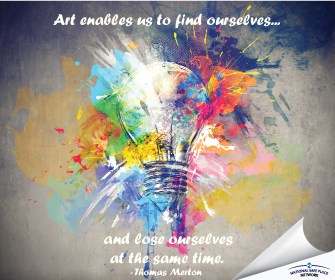5 Art Therapy Facts + 3 ways to Use Art in Your Therapy Practice Now
Written by Ginny Gaulin, Clinician & Art Therapist at RefugeeOne
You can’t walk into a bookstore without spotting several art therapy coloring books on the “What’s Hot Now” table. The coloring books are trending, but art itself has been used as a tool for communication for thousands of years. Art therapy as a health services profession has been official since the 1970’s, with founding figures utilizing art therapy starting in the early 1900’s. Today, more people than ever are engaging in and benefiting from art therapy.
Here are 5 important facts about to know about art therapy plus 3 ways to start successfully incorporating art into your therapeutic practice right now:
5 Important Art Therapy Facts:
- Art therapy is a masters-level mental health profession.
Using art for combating stress and facilitating relaxation is so beneficial, but it is not art therapy. Art therapists have specific national credentialing and licensure, and ethical art therapy can really only be practiced when facilitated by an art therapist. Learn more here and here.
- Art therapy is not only for young children.
As we mature, we quickly learn how to mask our emotions verbally. However, we are unpracticed at hiding emotions that are revealed in our artwork, making art therapy especially beneficial for clients of any age who are resistant to treatment or not used to talking about their feelings. Often the children that we see have learned early to build these defenses. Art therapy is for everyone.
- Artwork should be treated with confidentiality, like other clinical documentation.
Art therapists will not display artwork in hallways like art teachers in schools. If you treat the artwork and processes with clinical respect and power, the client will too. During final termination sessions, I will often display client’s artwork on my office wall like a gallery and the client can invite family members or teachers to view the work, but only with the client present.
- Self-discoveries through art are always more powerful than a therapist pointing out interpretations or observations.
Art therapy combines process, product, verbalizations, and interpretations of artwork. Yes, art therapists have clinical training in diagnostic art indicators, but no, we do not solely rely on them for diagnosing clients. Encouraging clients to make their own observations about their artwork is the goal.
- Artistic skill is not a requirement for treatment.
With the focus both on product and process, art therapists cannot say enough that we are not looking for artistic skill. Art therapists pick processes and materials intentionally to meet specific goals, which can range from reducing intimidation about art making to challenging clients artistically.
3 Ways to Use Art Right Now:
While practicing art therapy for healing is outside of a clinical counselor’s scope of practice, using art, or creative counseling, in treatment is highly impactful and encouraged!
- Use art to aid in communication – “Can you try to draw it instead?” is a great way break the ice when clients begin to show resistance to talk therapy. Keep materials within arms reach so it takes minimal effort to participate. If a client is immediately resistant, ask them to scribble on the page and use that to talk about their current experience. Avoid asking “what” or “why” questions, and try not to make guesses at what people have drawn, which can be unintentionally insulting and minimizing. Ask instead: What can you tell me about your drawing? How does looking at this make you feel? Where would you be if you were in this drawing?
- Use art as a ritual – Effective closure when ending sessions is healthy and important, and art can be a great way for clients to self-soothe. When short on time, be mindful of material choices, such as providing a smaller paper size and limiting options for drawing materials. This can keep things moving but also allows for the drawing to feel completed before leaving the session. Ask if there is anything the client would like to share about the image, but avoid diving deeper or asking specifics when seeking closure. Resist pulling these images out to finish up next time, and instead keep them in a folder for review later. Those external, tangible images can help document time spent in treatment and the progress made.
- Use art to build awareness – Create a handmade art journal with your client and encourage frequent entries. Ask them to take it home and draw when they experience a specific emotion they are working on in treatment. (This can become part of a therapy check-in process if you think your client will never touch the journal at home.) Later, encourage describing the artwork with words in the journal, which helps build mind-body connection and improve emotional identity skill.
Interested in going to school for art therapy? Learn more here.
Want to find a credentialed art therapist? Learn more here.





